In this post I want to do my best to thoroughly cover using the Chainmail rules to handle combat in Original Dungeons and Dragons. At least, to cover the necessary rules to get a handle on the basics.
Resources that I referenced while making this post:
- Dungeons and Dragons by Gary Gygax and Dave Arneson
- Chainmail by Gary Gygax and Jeff Perren
- The Compleat Chainmail Combat System – by The Grey Elf and others, and compiled by user Aldarron in 2011.
Hopefully by the end of this you will have a better understanding of how chainmail works in OD&D and maybe even find the chainmail rules interesting enough to use them at your own table.
What is Chainmail?
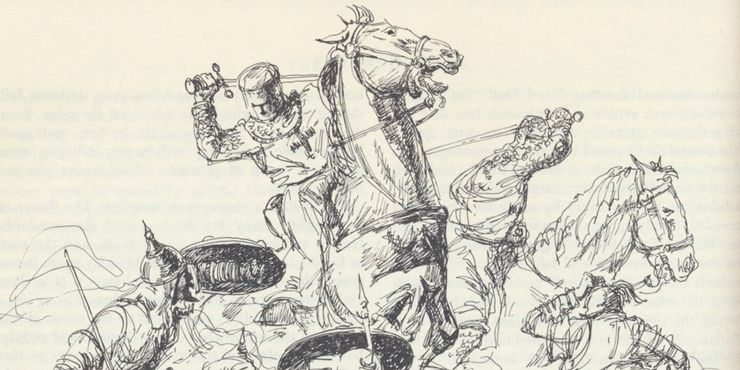
Chainmail is a wargame rules system for medieval miniatures with a fantasy supplement in the back of the book which was essentially the precursor to Dungeons and Dragons.
When the original Dungeons and Dragons game was released in 1974, the introductory section of the game recommended that the reader buy a separate game called Chainmail. The rules for D&D then had many instances that point the reader to “see Chainmail” for the relevant information. As many readers may be aware, D&D outsold Chainmail by a significant number, so the vast majority of players were not using the Chainmail rules in their home games.
This was all well and fine because the OD&D rules provided a fairly simple set of tables referred to as the Alternate Combat system which in later editions of D&D became the primary combat resolution mechanic.
Even Gary Gygax himself admitted their play group adopted the alternate combat system almost immediately after the release of OD&D.
So, why use Chainmail over the Alternate Combat System?
Well, hear me out.

First, let’s examine Chainmail and OD&D in context. We have to understand that the original concept of dungeons and dragons was an experimental way of playing a wargame. It was a granular approach to amassing wealth by delving into dark pits filled with danger, using that gold to build a warband and a defensible base to then lead your army to battle for power over the game world.
With that in mind, the potential for OD&D to resemble its wargame predecessors was built into the rules. An example of this is in the monster list in vol. 2 of OD&D, Monsters & Treasure—the number appearing of certain monster types in the wilderness could be in the hundreds. This would be an insurmountable wandering monster encounter for a standard party of adventurers, but not so for adventurers with a small army in tow.
However, the alternate combat system is not well suited for handling an encounter of 300 goblins, but it was probably never meant to. In later versions of the game, which all use iterations of the alternate combat system, such as Thac0 and the more modern d20 plus modifier mechanics, combat encounters see the wandering monster’s number appearing much lower—roughly comparable to the average party size in strength. It’s what the mechanics realistically can manage and are now built for.
Good news, Chainmail can handle both mass combat and normal monster encounters in D&D. Though, poorly laid-out and hard to navigate, the original medieval fantasy wargame rules are pretty neat once you parse out what is going on.
Another reason to explore using Chainmail is that there were many holes in the original rules that Chainmail was expected to fill. Though it was solved in later versions, there was no initiative system for combat nor was there a turn structure given in the Original three booklets. Many references to morale, some spells descriptions, and monster specifics are found in Chainmail, and without referencing Chainmail, it would be left up to house rulings to account for that missing info.
[End rambling, begin rules examination]
Brief summary of Chainmail
- D6 based rules set with three separate combat resolution systems—Mass combat, Man to Man combat, and Fantasy combat.
- Attack rolls are made with one or more d6s depending on the situation, number of attackers, or the combat system being used.
- There is also a whole section on jousting but I will save that for another post as it isn’t necessarily relevant to get started with chainmail.
- Fantasy Combat
- Fantasy combat is centered around combat between formidable fantasy creatures like Trolls, giants, dragons, and higher level PCs and is very simplified to resolve the conflicts quickly. If you find that you need to resolve a battle between an army of giants and some dragons, then the fantasy combat table can help. For most situations in the average session, the mass combat rules and the Man to man rules will cover you. For that reason, I won’t cover the fantasy combat rules here.
Fighting Capability
- The statistic that represents the number of men the character or monster fights as in Combat.
- The default fighting capability of any creature is equal to their HD.
- As mentioned in OD&D vol. 2, Attack/Defense capabilities versus normal men are 1 attack for every hit die. Any bonuses are applied to a single die roll of the attack dice thrown.
- The example given there is a Troll (being a 6 HD creature) rolls six dice, with a bonus of +3 applied to one of the attacks.
- Another example is the Fighter, which at level 1 has a fighting capability of Man + 1. So the attack of the level 1 fighting-man vs normal men or equivalent is 1 attack plus 1 to the attack die result.
Offensive and Defensive Bonuses
- Magic weapon bonuses such as Sword +1 grant an additional fighting capability.
- Our level 1 fighter with a +1 sword would have a fighting capability of 2 + 1 so would roll 2 dice for their attack, adding 1 to one of the rolls.
- Magic armor bonuses are the opposite—they remove fighting capability from the attackers.
- The level 1 fighter with a shield +1 defending against an ogre which has a fighting capability of 4 +1. The ogre would instead attack with a fighting capability of 3 + 1.
- Another note: a character with a +1 shield would be impossible for a single goblin with a fighting capability of one to hit, though 2 two goblins fighting together could get 1 attack in total.
This makes the acquiring of magic items in OD&D incredibly powerful.
Morale
Morale in combat is typically used only as an optional rule in modern rules systems. However, in OD&D and other early editions of the game, morale was just as integral to the game as it was for their contemporary wargames.
Player characters don’t check morale, they decide for themselves when to retreat or fight on.
When to check for morale for everyone else:
- After a third of the group or army has been killed.
- Being charged by cavalry.
- Before a combat if the odds of victory are very doubtful.
How to check for morale
There are three systems that both appear in Chainmail for determining morale—one for post melee which required complex math equations and percentages, another for suffering excess casualties, and another for being charged by cavalry. The only morale mechanics really necessary to be familiar with is morale based on excess casualties—the other two are either too edge case or too complex for our purposes.
In the PDF, the Compleat Chainmail, there is a fairly straightforward approach to checking for morale:
- Roll 2d6
- Add the sum of the levels of the player characters
- Subtract the sum of the monster’s total hit dice.
- A result of 7 or less, combat continues.
- 8-12 retreat in order, or negotiate if there’s no possibility to escape
- 13 or more, rout in disorder, or surrender if there’s no possibility to escape
Grappling
There are no official rules for grappling written for using chainmail, however there was an article written by Gary Gygax in summer 1975 for Strategic Review which uses a combat example between a 4th level fighter and 8 orcs. The Orcs attempt to grapple the hero and the Alternate Combat System is used to resolve the conflict. This can be converted to using the chainmail rules fairly simply.
- Declare grapple attempt
- Roll attacks
- On hits, no damage is dealt
- Both successful attackers and defender roll their fighting capability
- Compare results, adjudicate the outcome.
- Tie = both attackers and defenders are struggling, both standing. No weapons can be used in the next round.
- Defender high = attackers are thrown off, fall prone, and are stunned for a number of rounds equal to the difference is dice results.
- Attackers high = defenders are thrown down, are prone, and are stunned for a number of rounds equal to the difference is dice results.
Effects of Terrain on Movement
As is the case with many tabletop RPGs and certainly with wargames, terrain can play a huge role in how combat plays out. Some of these could be more applicable to standard combat encounters than others that mostly only affect troop formations. They’re fairly straightforward:
- Hills – Slows movement by 50% and prevents all charge moves, but movement downhill is at normal speed.
- Wooded – same as hill, but also prevents the movement of formed bodies of troops.
- Marshy – Same as hill, but also prevents the entrance of heavy equipment (such as siege equipment) and catapults.
- Rough – Prevents all charge moves.
- Ditches and Ramparts – same as hills.
- River and Streams – This is a little more mass combat centric. Treat individually for ford-ability and penalty for crossing. A typical stream would require 6” to cross and prevent charges. Rivers typically require troops to stop before and after crossing and cost an entire move to cross.
Turn Sequence
The turn sequence and initiative is found in Chainmail and can be used as is. However, the turn sequence given in the Compleat Chainmail feels cleaner and flows very well. The turn sequence plays out as follows:
- Sequence
- Reaction Phase
- Determine surprise (OD&D Vol. 3, page 9)
- Both sides roll a d6. Winner chooses to go first or second
- Retreats, routs, and fighting withdraws begin (if any).
- 1st Missile fire phase
- Elves may split move + missile fire
- Magic-user restriction regarding spells
- Magic-users cannot move under their own power or direct a mount AND cast spells.
- Casting magic-users struck by missile fire or engaged in melee lose their spell.
- Other side repeats the above following the same restrictions
- Action Phase
- Both sides move OR take some action
- characters or monsters can only move ½ their movement and engage in melee in the same round unless they charge
- If a character is charging, they must engage in melee
- They cannot charge the following turn
- Melees
- Pole weapons may get a free first attack if their action was to set their weapon against an onrushing attacker with a shorter weapon (or a lower weapon class, more on that later)
- Magic-users have their spells disrupted if they are engaged before the spell was cast.
- 2nd Missile Fire Phase
- Spells started in steps 2-3 take effect
- Missile weapons, except for crossbows that didn’t move AND haven’t been engaged in melee, can fire again.
- Other side repeats the above following the same restrictions
- New round begins
- Reaction Phase
Now that I’ve covered some of the general points of Chainmail and the turn sequence, let’s dive into the two main combat systems starting with Mass Combat.
Mass Combat Rules
The Mass Combat rules are useful for handling larger scale combats where groups of similar monsters are involved.
There are six classifications of troop types for D&D combat— three for infantry or foot soldiers(light, heavy, and armored) and the same for calvary. All creatures are classified as a certain troop type rating for attack and for defense. The ratings for each are determined by what armor the creature or player character is wearing and likewise for the weapons carried.
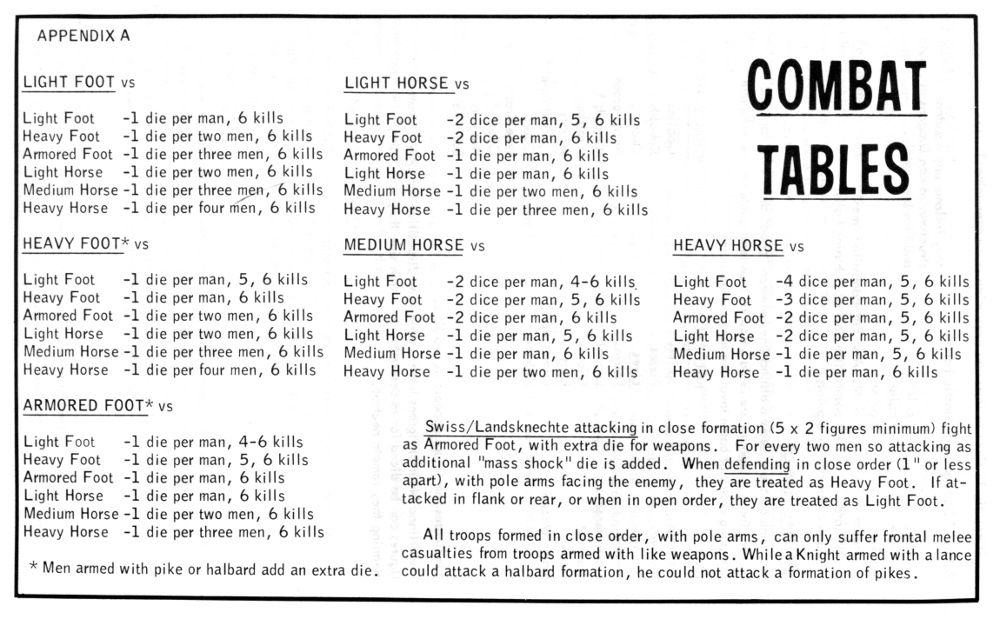
Here I’m referencing the work the authors of the Compleat Chainmail did to provide a concise list breakdown of Attack and Defense ratings by Classification.
Attack Rating
- Light Foot
- Arrow, Dagger, Hand axe, Javelin, Pick, Quarter Staff, Short Sword, Sling, Spear/Thrown
- Heavy Foot
- Battle Axe, Bolt, Flail, Mace, Morning Star, Spear/Thrust, BroadSword, War Hammer
- Armored Foot
- 2 handed Sword, Halberd, Lance, Pike, Pole Arms
Defense Rating ( Based on Armor Class)
- Light Foot
- AC 9-7 (no armor through Leather or Leather & Shield)
- Heavy Foot
- AC 7-4 (leather & Shield through Chain mail & Shield)
- Armored Foot
- AC 4-2 (Chain Mail & Shield through Plate & Shield)
AC 7 can be classed as either Light or Heavy and AC 4 can be classed as either Heavy or Armored, taking into account the fighting prowess and training of the creature. For Player characters, fighters and clerics assume the higher classification and thieves assume the lower.
Mass combat procedure
Attackers throw dice based on their Fighting Capability(the number of normal men they represent) and their Troop Type vs. the defender’s troop type as shown in Appendix A of Chainmail.
Mass Combat Example
Let’s look at an example combat encounter using the mass combat rules.
Our party of player characters consists of a lvl 2 cleric armed with a mace, and two lvl 1 fighters—one armed with a Sword and another wielding a battle axe. They recklessly kick the door into a dungeon room only to find a group of 4 Goblins all armed with short swords, leather armor & shields.
A roll is made for each side to see if either is surprised—neither is.
Initiative is rolled. The PCs get the initiative and they decide to engage the goblins.
For their actions, the PCs charge in to close the distance and get within melee range.
They attack. Based on the weapon class, all of the player characters have a troop type of heavy foot with a fighting capability of 1+1. The goblins have a defensive rating of light foot based on their armor and lack of training.
The players all throw their dice 1 die each looking for a 5 or a 6 to score a hit. The fighter swinging with the sword misses with a 2, but the cleric hits with a 6 and the axe-wielding fighter rolls a 4. Since his fighting capability is 1+1, he adds 1 to the roll making it a 5—enough to score a hit. They then roll their damage, killing two of the goblins.
With only half their group still standing, a morale check for the goblins must be made.
2d6 is rolled and comes up 5. Add the total levels of the PCs, 9, minus the total hit dice of the goblins, 2. The result is 7—the goblins stay in the fight, but just barely. The goblins then return blows.
Fatigue
Moving and fighting is exhausting and doing too much of it in any given battle is going to wear the combatants down. In Chainmail there is a list that shows what activities will cause fatigue and what happens when creatures reach that point.
- Moving 5 consecutive turns.
- Moving 2 turns, charging, then meleeing.
- Moving 1 turn, charging, then meleeing 2 rounds.
- Meleeing 3 rounds.
When combatants fulfill one of the above they become fatigued:
- They attack at the next lower value (ie. a fighter classified as heavy foot would then fight as light foot)
- They defend at the next lower value.
- Morale value drops -1 on values and for morale checks.
Tracking this could feel tedious but it could have an interesting dramatic impact on the battle.
Missile Fire in Mass Combat
At first glance, missile fire looks bewilderingly complex, but it’s actually simple. Though its use over the Man to man rules may not come up as often unless the PCs have amassed a small warband with a contingent of archers among them.
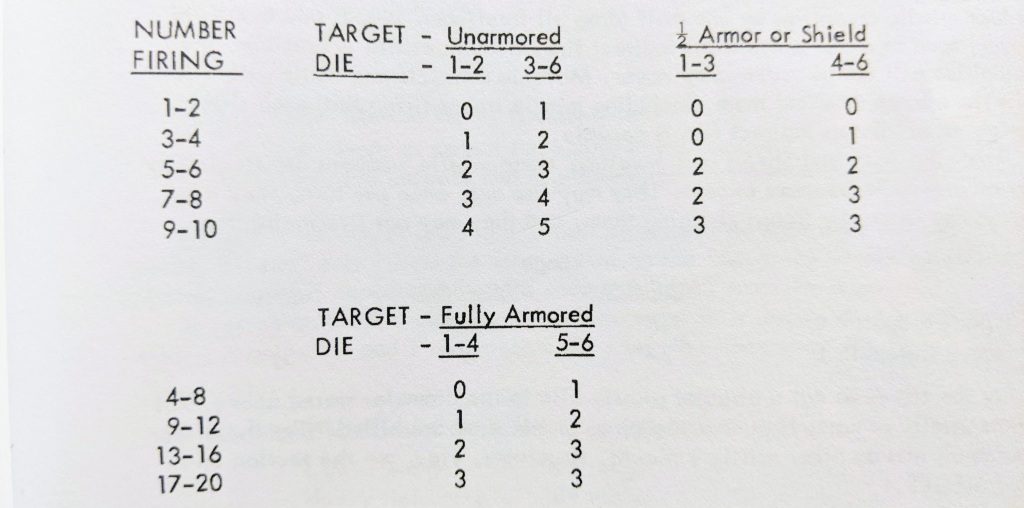
To have the table on Chainmail make more sense in D&D, we just need to refer to the category labels as such: Number Firing is interchangeable with Fighting capability, Unarmored is Light Foot, ½ armor or shield is Heavy Foot, and Fully armored is Armored foot.
Let’s use an encounter example to illustrate the table and its use. A higher level player character is traveling with their warband in an effort to clear the local region of monsters. As they march, scouts spot a group of bandits (classified as light foot). Four longbowmen are ordered to take the shot while they have the drop on them.
For a mass missile fire attack, only 1 die is rolled. It comes up a 3.
Referencing the table in Chainmail, that is enough to score 2 hits. Simple!
Rate of Fire

- Light Crossbows, Shortbows, and longbows can fire every turn.
- If archers using short bows and Longbows don’t move, and are not engaged in melee, they may fire again in the second missile fire phase.
- Can only fire if the archer moved half their movement rate, but if the are moved over half their movement, they may fire once ONLY if they beat their opponent’s die roll.
- This could be handled as written with a roll off between player vs referee or a Dexterity check or something.
- Heavy crossbows fire once every other turn with the same movement limitations, but they add 1 to missile fire rolls.
Pass Through Fire
Stationary creatures with missile weapons can choose to fire at enemies as they move if they are within range. The point at which the missile fire is taken is at the halfway point of the enemy target’s movement.
This could be ruled that the attackers would need to declare they are holding their missile fire in the first phase to be fired at the action phase.
Arc of Fire
The facing of creatures in Chainmail matters. The arch of fire allowed to the archers is 45 degrees.
Indirect Fire
In situations where archers, excluding crossbows, are attempting to fire over the heads of intervening friendly troops, indirect fire can be taken with the following stipulations.
- Must be at least 3” away from the target.
- Weapon range is reduced by ⅓
- The target is classified as the next higher troop type.
Hand axes, Spears, and Javelins
These missile weapons are like other missile weapons except:
- Only fire once per turn
- May always fire at enemies charging them
- Can’t fire indirectly
Man to Man Combat Rules
The rules for handling Man to man combats is slightly more complex but with that complexity comes more interesting mechanics. It might be a good idea to switch to man to man if there are fewer combatants involved and you wish to make the fight feel more cinematic or more immersive than just attacking and hoping to beat the target’s armor class.
The system takes into account weapon class to determine who will get the first blow in a melee or if the attacker can be parried. Weapons are ranked in ascending order from shortest and fastest (i.e. daggers and handaxes) to longest and slowest (i.e. 2 handed swords and pole weapons).
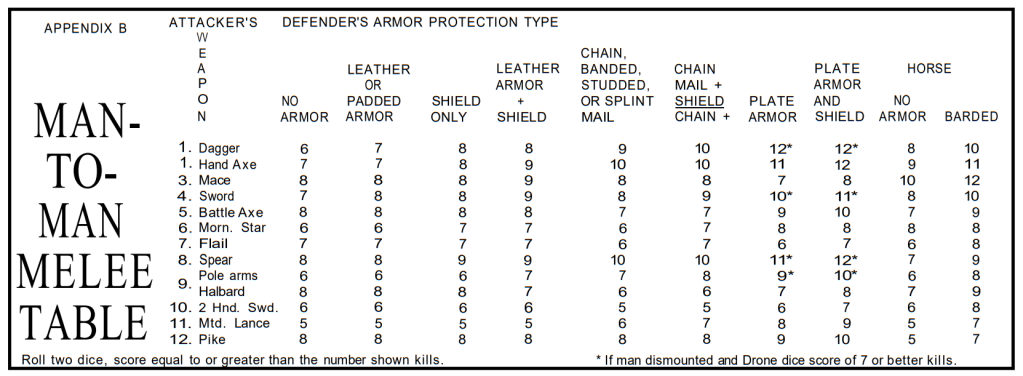
The Man to Man Melee table, Appendix B in Chainmail shows the weapons listed in order of class and what the attacker needs to roll on 2d6 in order to strike certain armor types of a defender. Examining the list you will see there are certain weapons that are better or poorer against different armor types.
Who attacks first in a given round also depends on the class of the weapons of the combatants. In Chainmail, this procedure is outlined as follows:
1st Round
- First blow is struck by —
- The attacker (ie. the side that has the initiative), unless
- The defender has a weapon which is two classes higher (longer), or
- The defender is fighting from above (castle wall, rampart, etc.)
2nd Round and thereafter —
- First blow is struck by —
- The side which struck the first blow previously, unless
- The opponent has a weapon that is two classes lower (lighter and faster), or
- The opponent is fighting from above
Those attacked from the rear do not return a blow in the first round.
Let’s look at an example.
A fighter wielding a sword rushes in to attack an orc with a spear. He has the initiative and would have the first blow, however, since the orc’s spear is 4 classes higher, the orc get’s the first attack.
In the second round, the orc would attack first, but the sword is faster, so the fighter gets the first blow.
There is another difference in weapon classes. As mentioned in Chainmail in the Man to man combat section regarding weapon class —The shorter and lighter the weapon, the lower its class. A [combatant] weilding a weapon four classes lower strikes two blows during every melee round. If they wield a weapon eight classes lower, they will strike three blows every melee round.
So in our example, the fighter with a sword attacking the orc with a spear would get 2 attacks every melee round.
It’s also noted that attacking from behind in melee will add one to the roll of the attacker. In that situation, the Defender would not get to return a counter attack.
Parry
This to me is what makes Chainmail incredibly interesting for D&D. By utilizing the weapon class system, the combat encounter becomes a tense cinematic duel. I’ll go over the mechanics and then go back to our previous example.
- For any weapon 2 or more classes higher than the attacker the ability to parry does not exist.
- For any weapon 1 class higher to three classes lower than the attacker the defender may parry the blow by subtracting 2 from the attacker’s roll, but he has no counter blow.
- For any defender whose weapon is four to seven classes lower than the attacker, the defender has the option to give the first blow OR parry the attacker’s blow, by subtracting 2 from the attacker’s roll. If the attacker equals the original requirement for a kill the higher weapon breaks the defender’s weapon. If the parry is successful, the defender gets one counter blow.
- For any weapon whose class is eight or more classes lower than the attacker, the defender gets the first blow and may parry the second or strike the second. He subtracts one for the parry and a roll equal to the original kill requirement breaks the weapon. (Pikes, spears or lances of the attacker do get the first blow over lower class weapons if there is a charge. Here the length of the weapon prevents the defender, even with his lighter weapon, the ability to get the first blow.)
– Chainmail, page 25-26
Back to our Orc encounter. The fighter with initiative rushes in to attack the Orc who will get the first blow because the spear is over 2 classes higher than the sword. The fighter declares that he will parry the attack, wagering his faster weapon will gain him a counter-blow should he successfully parry. With a -2 added to the attacker’s roll, the attack is parried and the fighter returns a counter blow, killing the orc.
Individual fires with missiles.
The Individual Fires with Missiles table covers man to man missile fire and is structured much the same way. The key difference is there are different target numbers per weapon versus armor type needed to roll on 2d6 for close, medium, and long range. The ranges are just the maximum range for the weapon broken up into thirds. For instance, the longbow’s range is 21” (as noted in Chainmail) so short range would be 1-7”, medium would be 8-14”, and long would be 15-21”.

What About Encounters with Monsters that don’t have weapons or wear armor?
Let’s say our fighter has survived until the 4th level, acquired some magic items along the way (a +2 sword, armor and shield +1) and has found herself facing off against a Manticore. The manticore doesn’t carry weapons or wear armor—though in the monster’s description in Vol. 2 does state the tail spikes are equivalent to crossbows. That is actually enough information to go on.
We can determine the manticore’s troop type then. The crossbow bolt attacks as Heavy Foot and AC 4 could be either Heavy or Armored foot, depending on how experienced we rule the monster is. For the sake of this encounter, we decide the manticore attacks and defends as Heavy Foot.
The manticore is encountered in the dungeon and neither party is surprised. The manticore gets the initiative and attacks the fighter with its tail spikes. It gets to fire those 6 at a time, because it says so in the description, but also notice its fighting capability is 6+1. Versus the fighter’s fancy magic armor, the attack is reduced to 4+1, Heavy foot vs Heavy foot so hitting on 6s.
The attack is rolled: 2, 3, 5, and 6. Adding the +1 of its fighting capability to the 5 results in 2 hits.
Our fighter takes some damage, but rushes forward to engage the manticore in melee.
Conclusion
And that is basically everything for using Chainmail to resolve combats in your OD&D games. There are other elements of combat found in Chainmail such as catapults and Jousting that I didn’t cover, but I may cover them in a follow up post.
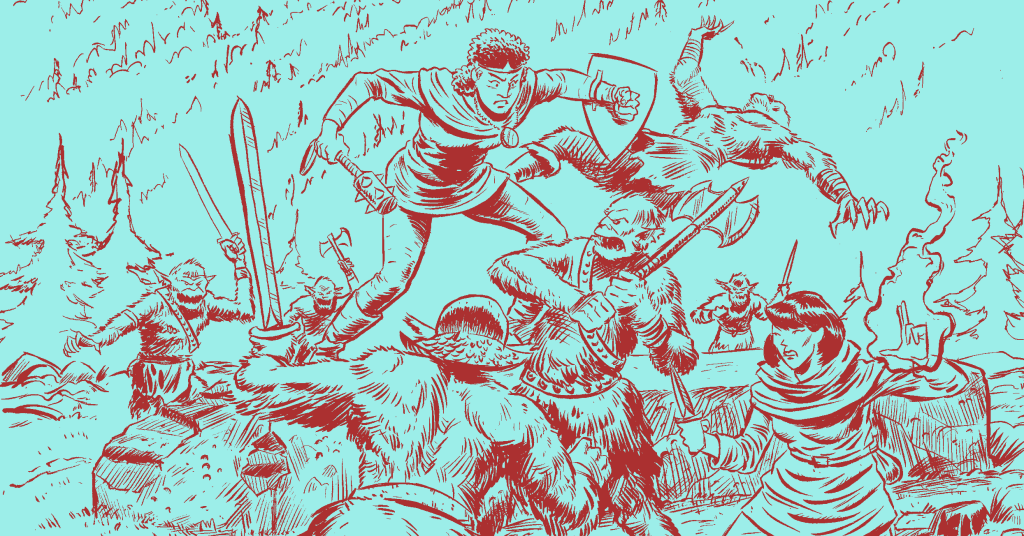
6 responses to “Using Chainmail with OD&D”
Just wanted to say thanks for this, I have been running OD&D and have always been a little mystified by some of the Chainmail-ier elements and this is a clear breakdown. So on this basis, Magic Weapons and Magic Armour have the same effects even when the Alternate Combat system is used? If so doesn’t that mean a Level 1 Fighter using a +1 Magic Sword would see no effect against monsters (since even if attacking with extra fighting capacity, he’d still be fallin within the Level 1-3 range in the Men Attacking matrix?
LikeLiked by 1 person
I think there is still a fairly good boost to the level 1 fighter. Here is the section “Offensive Bonuses” in The Compleat Chainmail booklet:
“Offensive bonuses, such as the plus rating of a magic sword are added to the die total in the Man to Man and Fantasy Combat Tables. For mass combat, each point of bonus grants an additional d6 to Hit Dice or Fighting Capability.”
This is the interpretation by Grey Elf of essentially what is said on page 38 of Chainmail on the topic of Magic Weapons. My understanding is that magic weapons add extra attacks whereas magic armor subtracts the extra attacks granted by fighting capability.
LikeLike
Wouldn’t the manticore fight fall on the fantastic creature chart? I love this style of play. Been studying for awhile now.
LikeLike
I think you may choose whatever fits you. And for example it would be hard (specified) to rule fight with Manticore for PCs less then 4 lvl.
LikeLike
It absolutely would. I’m trying to come up with what its chainmail equivalent stats might look like. If you have some notes on that, I’d love to see what you have.
LikeLike
> characters or monsters can only move ½ their movement and engage in melee in the same round unless they charge
Do you know why it’s “only move ½ their movement” there? Couldn’t find anything about that in LBB/Chainmail.
LikeLike